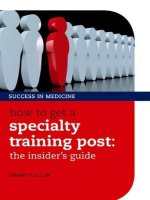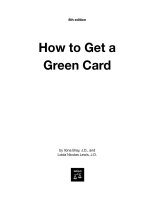How to Use This Book to Get a Top Score
Bạn đang xem bản rút gọn của tài liệu. Xem và tải ngay bản đầy đủ của tài liệu tại đây (110.32 KB, 22 trang )
Chapter
1
How to Use This Book
to Get a Top Score
I
f you are planning to take the TOEFL exam, you are not alone.
Worldwide more than 700,000 people will likely take the Test
of English as a Foreign Language (TOEFL) this year. Native
speakers of 145 different languages—representing more than 220
countries and regions—take the TOEFL exam annually. And, over
4,500 colleges, universities, programs, and agencies in the United
States and Canada will use the TOEFL exam to evaluate applicants
who are not native speakers of English. This important test mea-
sures your ability to read, write, and understand English so you can
succeed in a college classroom or professional program.
To prepare for the TOEFL exam, unlike other standardized
tests, you can’t just memorize a list of vocabulary words or math
formulas and expect to do well on the exam. You need to under-
stand conversations and other spoken English, know grammar
rules, understand and process what you read, and be able to
1
2 TOEFL EXAM ESSENTIALS
express yourself effectively in writing. As you sharpen your
English-language skills to prepare for the exam, this book will
highlight what you need to know to get your best score.
If you have looked on the shelves of your local bookstore, you
know the volume of test-preparation tools and guidebooks can
be overwhelming. That’s why this guide is designed to focus on
the most important parts of studying for the TOEFL exam, with-
out weighing you down. TOEFL Exam Essentials pulls together
all the pieces of test preparation for you:
■
what to expect on the test
■
successful test-taking strategies
■
how to make your own study plan
■
a review of the content and skills you need to know
You can take this book with you wherever you go. Take it out
while you wait for the bus, during a work break, or while you exer-
cise at the gym. It fits in your pocket or purse so you can fit your
study time into a busy schedule. By using this book, you are tak-
ing your first steps to earning a top score on the TOEFL exam.
Good luck as you prepare for the exam and pursue the education
you need for a successful future.
WHAT THE TOEFL EXAM IS ABOUT
The TOEFL exam has two formats: a computer-based test and
a paper-and-pencil version. You can take the computer-based
test (CBT) at test centers around the world throughout the year.
In some areas, the CBT is not available and the paper-based
TOEFL exam is offered instead. The paper test is offered six times
a year at specific locations. Although the test designs for the
HOW TO USE THIS BOOK TO GET A TOP SCORE 3
CBT and the paper-based test are different, both versions mea-
sure the same skills and use similar content for reading passages
and recorded conversations.
The computer-based TOEFL exam has four components: lis-
tening, structure, reading, and writing.
■
The listening section tests your ability to understand
North American English. You will use headphones to
listen to conversations and lectures and then answer
multiple-choice questions about them. You will be asked
to locate main ideas, supporting ideas, and understand
inferences made in the conversations that you hear.
■
The structure section measures your knowledge of
grammar and usage in standard written English. You will
read sentences and locate grammatical errors or
complete sentences with an appropriate word or phrase.
■
The reading portion of the exam will measure your
ability to read and understand short, written passages.
The passages will have a style and subject matter similar
to that of college-level academic texts.
■
The writing section will ask you to compose a short
essay on a general topic selected by the computer from a
large set of possible topics. It measures your ability to
write in English and develop and organize ideas about
an assigned subject.
You will have about four hours to complete the CBT. Before
you begin the test, you will go through a tutorial about basic com-
puter skills, including how to use a mouse, how to scroll, and how
to use testing tools. Each test section also begins with a tutorial that
4 TOEFL EXAM ESSENTIALS
will demonstrate how to answer test questions in that part of the
exam. These tutorials are not scored, and you can spend as much
time on them as you need. You can also take these tutorials prior
to the test for no charge at www.toefl.org or purchase a download-
able file. It is a good idea to practice your computer skills ahead of
time and become familiar with how to answer test questions using
a computer—this will be an advantage to you on exam day.
The paper-based TOEFL exam has three sections: listening
comprehension, structure and written expression, and reading
Computer-Based TOEFL Exam
Number of Time Computer
Section Questions Limit Adaptive?
Tutorials 7 tutorials No time limit No
Listening 30–49 15–25 minutes Yes
to answer questions
40–60 minutes total
(You will not be
timed while you
listen to recordings;
only while you
answer questions.)
Structure 20–25 15–20 minutes Yes
Reading 44–55 70–90 minutes No
(This includes the
time it takes you to
read passages and
answer questions.)
Writing One topic 30 minutes No
HOW TO USE THIS BOOK TO GET A TOP SCORE 5
comprehension. Each section consists of multiple-choice ques-
tions with four possible answer choices for each question. Although
the test format varies from the CBT, the skills measured are
the same.
■
Listening comprehension tests your ability to under-
stand North American English, including use of idiom
and vocabulary.
■
Structure and written expression tests your ability to
recognize grammatical errors in standard written
English and complete sentences with an appropriate
word or phrase.
■
Reading comprehension asks you to read and answer
questions about short passages like those used in
college-level texts.
The Test of Written English (TWE), a 30-minute writing
test, is a required part of the paper-and-pencil TOEFL exam on
What Is Computer-Adaptive Testing?
Some sections of the computer-based TOEFL exam are
computer adaptive, which means the computer selects
your questions based on your level of proficiency. Your first
question will have an average level of difficulty. Your next
question will either be easier or harder, depending on how
you answered the first. The listening and structure parts of
the exam are computer adaptive, but the reading and
writing sections are not.
6 TOEFL EXAM ESSENTIALS
most test dates. There is no separate fee for the TWE. You will
write a short essay about an assigned general topic.
What about your test score? The TOEFL exam has no
single passing score. The college, university, or agency to which
you are applying decides the minimum test score that it accepts.
To learn more about how the TOEFL exam is scored, see
Appendix A.
MANAGE YOUR TIME
If your life is busy, you may wonder how you will find the time
to prepare for the TOEFL exam. You can’t make each day longer,
but effective time management—how you organize and use your
time—can help make the most of the time you have to get ready
for the exam. Managing your time during the exam is also an
important skill.
To manage your time before the exam, evaluate how you
currently use your time. Follow these steps to better organize your
time:
Paper-and-Pencil TOEFL
Number of
Section Questions Time Limit
Listening comprehension 50 30–40 minutes
Structure and
written expression 40 25 minutes
Reading comprehension 50 55 minutes
Test of Written English ( TWE) One topic 30 minutes
Note: Number of questions and time limits may vary.
HOW TO USE THIS BOOK TO GET A TOP SCORE 7
■
Review your current activities and obligations,
including recurring ones like classes, your work
schedule, your exercise or sports schedule, or religious
services.
■
Prioritize your activities. Which are the most
important to you? Are there any activities you can
eliminate to make more time to prepare for the TOEFL
exam?
■
Work out a weekly schedule. Make a list of your major
weekly events, including your TOEFL exam study goals
for the week. (See more about creating a successful study
plan later in this chapter.) List any major social, work, or
school-related events (for example, a vocabulary test in
Register Right Away
Test centers fill up quickly, so begin the TOEFL exam
registration process right away. Registration information is
available online at www.toefl.org or in the TOEFL exam
Bulletin, available at English language centers or at the
international student center at the university to which you
are applying. You can also request a Bulletin by writing to:
TOEFL/TSE Services
P.O. Box 6151
Princeton, NJ 08541-6151
609-771-7100
8 TOEFL EXAM ESSENTIALS
English class). Ideally, create this schedule for each week
of your test preparation period.
■
Create a daily “to do” list. Write down your activities,
including your TOEFL exam study goals for the day.
Make this list daily, before bed, or first thing in the
morning. Carry it with you and cross out the items that
you have accomplished.
Managing your time effectively while you are actually taking
the TOEFL exam is a crucial skill. As outlined earlier in this chap-
ter, each section of the TOEFL exam has a specific time limit.
You are expected to complete each section within that given
amount of time. Because you know how much time you have, you
can pace yourself and budget the amount of time you would like
to spend on each question.
If you are taking the computer-based TOEFL exam, an
onscreen clock display will keep track of the current question num-
ber, the total number of questions, and the time you have left to
answer them. For example, if you are halfway through a section
with 30 questions, you may see a display that shows question 15
of 30 and 00:09 minutes remaining. The display continuously
changes as you go through the section.
To help you manage your time during the exam, review these
guidelines:
■
Sharpen your computer skills if you are taking the
computer-based exam. Even if you use a computer every
day, taking a test on a computer may be unfamiliar to
you. Go to the TOEFL exam website (www.toefl.org)
for free online tutorials before exam time.









